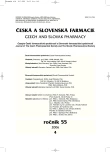A Study of Qualitative Properties of the Essential Oil of Tanacetum vulgare L.
Authors:
Š. Vaverková; M. Mikulášová 1; M. Habán 2; P. Sloboda
Authors‘ workplace:
Univerzita Komenského v Bratislave, Farmaceutická fakulta, Katedra farmakognózie a botaniky
; STU Bratislava, Fakulta chemickej a potravinárskej technológie, Katedra biochémie a mikrobiológie
1; SPU Nitra, Fakulta agrobiológie a potravinových zdrojov, Katedra agrobiológie a herbológie
2
Published in:
Čes. slov. Farm., 2006; 55, 181-185
Category:
Original Articles
Overview
The study examined the qualitative properties of the essential oil obtained from the flower heads of the species Tanacetum vulgare L. The composition of the essential oil was evaluated in plants from various localities, which differed in the altitude, temperature gradient, as well as soil-climate conditions. With the use of gas chromatography (GC/MS), 49 constituents of the essential oil were separated, out of which 35 was identified. The shares of the constituents in the essential oil differed in dependence on the locality. In the lowest-lying locality with a relatively large sunshine, the content of ß-tujons in the essential oil was the highest, whereas in the regions lying towards the north the content of the essential oil was decreased and the content of camphor was increased. In the northernmost region an increased number of chemovars of the camphor-cineole type was observed. In conclusion, it must be said that different climatic and agrotechnical conditions, geographical origin and adaptation of the genotypes of Tanacetum vulgare to the growth conditions can be the causes of the found chemotypes in the localities under examination.
Key words:
Tanacetum vulgare L. – essential oil – chemotype
Labels
Pharmacy Clinical pharmacologyArticle was published in
Czech and Slovak Pharmacy

2006 Issue 4
Most read in this issue
- Angiotensin Converting Enzyme Inhibitors
- Naphthoquinones – biosynthesis, occurrence and metabolism in plants
- Properties of Benzethonium Chloride in Micellar Solutions and the Effect of Added Sodium Chloride
- Protective Effects of the Flavonoids Osajin and Pomiferin on Heart Ischemia – Reperfusion
